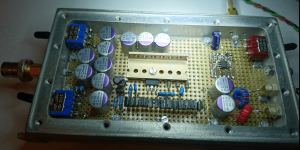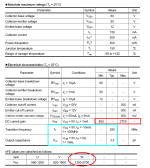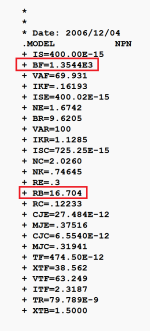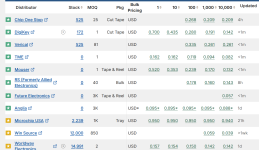Get a copy of Horowitz and Hill. There’s a whole section on low noise bipolars.A switching transistor?
Apparently that ZTX951 is very low noise.. I assume the DZT951/DTZ851 use the same die, but in an SMD part, right?; https://www.diodes.com/assets/Datasheets/ds30786.pdf
What other good low noise transistors are there? I mean, yeah there's those on that list but it's not very comprehensive.
The ZTX851/951 and their SMD equivalents are the lowest noise by quite some margin. They are switching transistors and to cater for fast switching they have low base resistance which iao things is great for low noise. They make great dynamic mic and MC front end amplifiers.
So tell me what’s compelling about this? I may as well be looking at a BC546/556 data sheet (which has more information BTW).What about this?🤔View attachment 1230863
D
Deleted member 550749
Bc549c/550c/560c all these r low noise, with higher hfe , 👍 I have bc549c germanium transistor old but has performance very nice 👍 in India not available also if available that will b fake or too high price, but s9014c/15c everywhere available and and if I compare with ktc1845/992 at voltage range wins otherwise everything is same , but BC series r also good 😊
Anything that is “available anywhere” may or may NOT be what you think it is or what they say it is. Unless it comes from an authorized distributor you simply have to take what the seller says ON FAITH.
If you are REALLY worried about noise performance I would not take it ON FAITH. For power amp input stages probably anything they sell you is probably quiet ENOUGH. But is it what they say it is? Use it in a mic pre or MC phono stage and find out. You may get lucky, you may get HISSSSSSS.
If you are REALLY worried about noise performance I would not take it ON FAITH. For power amp input stages probably anything they sell you is probably quiet ENOUGH. But is it what they say it is? Use it in a mic pre or MC phono stage and find out. You may get lucky, you may get HISSSSSSS.
...Bc549c/550c/560c all these r low noise, with higher hfe , 👍 I have bc549c germanium transistor old
but BC series r also good 😊
BCxxxx can never be germanium. In the Pro-Electron naming system:
1st letter: A = germanium, B = silicon, C = GaAs ( definition really by bandgap voltage)
2nd letter: A = Diode, B= varicap, C = ordinary small BJT, D = power BJT,
F = RF BJT or FET, L = RF power FET, there are more..
3rd letter: if present = pinout options, gain, letters from the end of the ABC = pro use
So there is no "BC series".
Get a copy of Horowitz and Hill. There’s a whole section on low noise bipolars.
The ZTX851/951 and their SMD equivalents are the lowest noise by quite some margin. They are switching transistors and to cater for fast switching they have low base resistance which iao things is great for low noise. They make great dynamic mic and MC front end amplifiers.
Yes. And their ribbon mic preamp works as they write.
I built a single ended version of it with only 16 instead of 64 transistors
and got the promised 75 pV/rtHz noise density.
I pay with a lot of input capacitors for the missing 48 transistors, but
I needed it single-ended anyway and the measured signals usually
ride on a DC. And the current noise is less.
There is also the ZXTN2018FTA in SOT-23 with the same performance.
The marking on on the SOT-23 is 851, probably for a reason.
Attachments
That used to be the home of some RF electronics made by Kathrein.
I bought half a dozen from ebay and emptied them. Top and bottom
plates are from steel. The proto board with ground mesh:
www.segor.de
I bought half a dozen from ebay and emptied them. Top and bottom
plates are from steel. The proto board with ground mesh:
www.segor.de
I asked about them too. can't find any noise chart for them, only a typical rating of "0.9db" iirc the PNP one was down to 0.8db ratingSo tell me what’s compelling about this? I may as well be looking at a BC546/556 data sheet (which has more information BTW).
They're very linear tho, much more than something like the 2SA992 or 2SA1015, etc.
There is no correlation between the noise measurement values based on view measurement methods and hearing measurement methods. All that remains is to buy > 10 different types, one type of which you will judge to be low-noise, or at least low-noise, after a listening test.
The sound characteristics can also only be determined by listening comparison. Buy 50 different types and you will get 2 or 3 that are convincing in terms of both audible noise behavior and sound.
Unfortunately, you also have to buy the quantity you need for your projects and their maintenance, because new or different batches can differ considerably in terms of audibility.
The sound characteristics can also only be determined by listening comparison. Buy 50 different types and you will get 2 or 3 that are convincing in terms of both audible noise behavior and sound.
Unfortunately, you also have to buy the quantity you need for your projects and their maintenance, because new or different batches can differ considerably in terms of audibility.
Yes there is. What I think is confusing you is the turnover frequency of the noise. High bandwidth transistors usually have a higher turnover frequency. So while you maybe have 1nV noise at 10khz, it may be up near the 100nV mark at 100hz. while another transistor might have 5nV noise at 10khz but have only 20nV at 100hz. Which may sound less noisy than the other one, despite it having a lower "typical" noise rating most likely.
Hi.We are making Marantz MA9s2 clone.There are many transistors for HDAM units and amplifier inputs.
We are wondering what is " Low pulse noise" at 2sc2240 datasheet
We need as high voltage as 2sc2240 but it is rare and expensive.
What will be alternatives?
Is KTC3200 and KTA1268 better than KSC1845-F and KSA992-F ?
Regards
We are wondering what is " Low pulse noise" at 2sc2240 datasheet
We need as high voltage as 2sc2240 but it is rare and expensive.
What will be alternatives?
Is KTC3200 and KTA1268 better than KSC1845-F and KSA992-F ?
Regards
I used a whole bunch of BCM56DS and BCM53DS dual transistors in a low-noise bandgap reference some time ago, with quite good results. Yesterday I measured the noise of a BC639 and BC640, which are supposed to be single TO-92 versions of the same transistors, and calculated a base resistance of about 3.5 ohm for the PNP and 6.1 ohm for the NPN from the results.
By the way, see post #66 of this thread https://www.diyaudio.com/community/threads/noise-measurement-amplifier.410828/post-7658554 for the list of some bipolar transistors from The art of electronics.
I've read that chapter, but still not sure if I got this right - ZTX851 has lowest noise with a current around 10mA. So probably circuit shall be altered to that. Also, it seems that the whole ZTX series is very low noise. I can get ZTX450 locally for reasonable price, what do you guys think about them?Get a copy of Horowitz and Hill. There’s a whole section on low noise bipolars.
The ZTX851/951 and their SMD equivalents are the lowest noise by quite some margin. They are switching transistors and to cater for fast switching they have low base resistance which iao things is great for low noise. They make great dynamic mic and MC front end amplifiers.
What circuit are you referring to?
When the source impedance is very low, like in a moving-coil phono preamplifier, it is the equivalent input noise voltage that matters, because the effect of the equivalent input noise current is then very small. In that case, you can best use a transistor with a low base resistance biased at a fairly large current, such as 10 mA.
When the source impedance is not very low, there is an optimal collector current that leads to the smallest overall noise.
When the source impedance is very low, like in a moving-coil phono preamplifier, it is the equivalent input noise voltage that matters, because the effect of the equivalent input noise current is then very small. In that case, you can best use a transistor with a low base resistance biased at a fairly large current, such as 10 mA.
When the source impedance is not very low, there is an optimal collector current that leads to the smallest overall noise.
Nothing wrong with 2SD2704K either. Rb only 3.18 Ω.
.MODEL Q2SD2704K NPN
.MODEL Q2SD2704K NPN
- IS=250.00E-15
- BF=2.3219E3
- VAF=100
- IKF=25.778E-3
- ISE=270.34E-15
- NE=1.8069
- BR=45.088
- VAR=100
- IKR=9.4796
- ISC=411.09E-15
- NC=2.0254
- NK=.54182
- RE=.4
- RB=3.1823
- RC=58.585E-3
- CJE=8.7706E-12
- MJE=.66324
- CJC=15.709E-12
- MJC=.53302
- TF=3.8352E-9
- XTF=32.147
- VTF=472.13
- ITF=85.294
- TR=7.0574E-9
- XTB=1.5000
Attachments
- Home
- Amplifiers
- Solid State
- Low noise bipolar transistors for audio?



